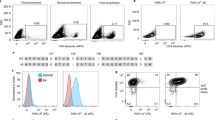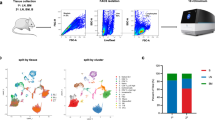Abstract
The human HLA-D region, the presumed evolutionary homologue of the H–2 I region in mouse and similar genetic regions in other species1, codes for multiple antigenic determinants, a finding consistent with the existence of multiple loci2,3. One method developed to define D region encoded determinants is primed LD typing (PLT) wherein cells of one individual are primed in vitro in a mixed leukocyte culture (MLC) to allogeneic HLA-D encoded determinants associated with one haplotype4,5. The PLT cells give a rapid proliferative response when restimulated in secondary culture with either the priming cells or third party cells that carry the priming antigen(s). However, as in many cases a PLT cell is probably primed to several determinants, different restimulating cells from unrelated individuals will engender a range of responses varying from very high to very low, presumably depending on the number of determinants shared (or cross-reactive) between the priming and restimulating cells. Such results are difficult to interpret in terms of defining antigenic determinants on the cells of various individuals. Fathman and Hengartner6 have circumvented this problem in mouse by cloning murine T lymphocytes from multiply restimulated PLT cells; the progeny of any one clone give highly specific proliferative responses. We report here the use of the supernatant of phytohaemagglutinin (PHA)-stimulated mixtures of human allogeneic cells7,8 (designated T-cell growth factor or TCGF) to grow ‘clones’ of human T lymphocytes following alloactivation in MLC. Clones that give PLT-type responses do so in a highly antigen-specific manner. Following cloning, cells in many cases have undergone 25 or more divisions, thus yielding in excess of 1×108 progeny.
This is a preview of subscription content, access via your institution
Access options
Subscribe to this journal
Receive 51 print issues and online access
$199.00 per year
only $3.90 per issue
Buy this article
- Purchase on Springer Link
- Instant access to full article PDF
Prices may be subject to local taxes which are calculated during checkout
Similar content being viewed by others
References
Bach, F. H. & van Rood, J. J. New Engl. J. Med. 295, 806–813; 872–878; 927–936 (1976).
Dupont, B. et al. in Histocompatibility Testing 1975 (ed. Kissmeyer-Nielsen, F.) 547–551 (Munksgaard, Copenhagen, 1975).
Bach, F. H. et al. in Histocompatibility Testing 1975 (ed. Kissmeyer-Nielsen, F.) 576–580 (Munksgaard, Copenhagen, 1975).
Sheehy, M. J., Sondel, P. M., Bach, M. L., Wank, R. & Bach, F.H. Science 188, 1308–1310 (1975).
Bach, F. H. et al. Scand. J. Immun. 6, 469–475 (1977).
Fathman, C. G. & Hengartner, H. Nature 272, 617–618 (1978).
Morgan, D. A., Ruscetti, F. W. & Gallo, R. C. Science 193, 1007–1008 (1976).
Gillis, S. & Smith, K. A. Nature 268, 154–156 (1977).
Hartzman, R. J. et al. Transplantn Proc. 10, 809–812 (1978).
Reinsmoen, N. L., Noreen, H. J., Sasazuki, T., Segall, M. & Bach, F. H. Proceedings of the 13th Leucocyte Culture Conference (in the press).
DeWolf, W. C., Carroll, P. G. & Yunis, E. J. J. Immun. 122, 860–865 (1979).
Miller, C. R. & Phillips, R. A. J. cell. Physiol. 73, 191–203 (1969).
Author information
Authors and Affiliations
Rights and permissions
About this article
Cite this article
Bach, F., Inouye, H., Hank, J. et al. Human T lymphocyte clones reactive in primed lymphocyte typing and cytotoxicity. Nature 281, 307–309 (1979). https://doi.org/10.1038/281307a0
Received:
Accepted:
Issue Date:
DOI: https://doi.org/10.1038/281307a0
This article is cited by
-
Interleukin 2 activity in peripheral blood mononuclear cells of patients with gynecologic malignancies
Medical Oncology and Tumor Pharmacotherapy (1988)
-
Experimental strategies for the study of cellular immunity in renal disease
Kidney International (1986)
-
Human allospecific TLCs generated against HLA antigens associated with DR1 through DRw8
Immunogenetics (1986)
-
Recognition of class II molecules by human T cells
Immunogenetics (1986)
-
Human allospecific TLCs generated against HLA antigens associated with DR1 through DRw8
Immunogenetics (1986)
Comments
By submitting a comment you agree to abide by our Terms and Community Guidelines. If you find something abusive or that does not comply with our terms or guidelines please flag it as inappropriate.



